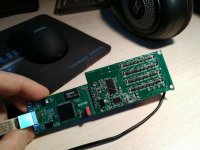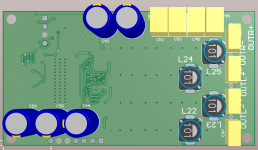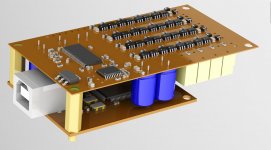Hi guys, does someone listened really digital headphone amp ever? So-called Power DAC? I ready to bet if mine is most digital one! )) Why??77 Just because I used standard LVC logic as a power stage. Actually, it is well argumented choice for a headphone's amp due to very fast switching of the LVC logic gates and relatively high output current. Sure, a single gate has no enough output current to drive my HiFiMan HE400i, but tied (32pcs/ch) in parallel does work fine. Fortunately, HE400i has differential inputs(4 wires instead of 3), so using H-bridge output stage making possible to use 5V USB power for a whole thing, with a lot of SPL room. Here we go: CM6631A->TAS5558->64pcs of LVC invertors + STM8S003 MCU to control TAS5558 digital modulator. TAS5558's 4 PWM modulators tied in parallel for the left channel, and another 4 for the right. I had idea regarding step-up boost invertor to lift up and regulate >5V but finally gave up that for simplicity. I have to say that this is an open loop design i.e. no any f** feedback is implemented there, so S/N -94db(A) wasn't surprising for me(powered by dirty USB). However, -94db is the noise level which almost matched with theoretical CD (16/44) resolution. Furthermore, my headphones are opened back type so I feel zero noise with it(Power DAC noise just masked by environment noise). THD at 1/2 max power and HE400i load .02% but THD+N .04%, if TAS5558 and output stage powered from the same 3.3V rail THD and THD+N pretty much the same and looks much better(on the moderate volume I saw .003%) but output power become less. The sound to me is crazy detailed and dry(neutral, no harshness) as actually, planars like HE400i does.
Attachments
Last edited:
I have built (well not from scratch, heavily modified) a number of 'digital' headphone amps, some using STA3xx chips and some using D2Audio chips with discrete MOSFET output stages. All used transformers for step-down and to allow me to drive standard 3-wire headphones. And yes, the sound is extremely good - dynamic and shed-loads of details (the right kind of details I mean, not 'detail').
Highly recommended.
Highly recommended.
Two PCBAs(USB as a first, DAC as the second floor) fits 76x41x25mm of space, so it could look like long USB cable, little Power DAC case and short two cables to headphones i.e. pretty much like a fat cable 
Attachments
abraxalito, got it, however, LVC output 100% outperform your discrete mosfets regarding dead time distortion  Look at this(sorry I mixed up the THD figures with my HiFi-TOY MK-2 project, which is also open loop but 2x100W yet):
Look at this(sorry I mixed up the THD figures with my HiFi-TOY MK-2 project, which is also open loop but 2x100W yet):
Attachments
-
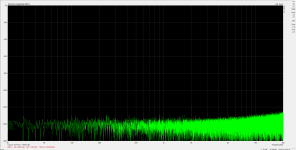 2018-08-28_18-20-22.png124.5 KB · Views: 193
2018-08-28_18-20-22.png124.5 KB · Views: 193 -
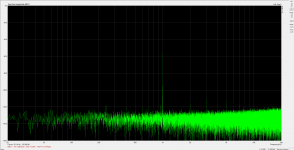 2018-08-28_18-17-55.png132.4 KB · Views: 180
2018-08-28_18-17-55.png132.4 KB · Views: 180 -
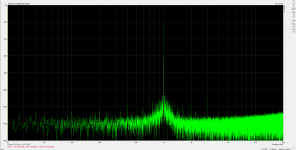 2018-08-28_18-15-12.png133.9 KB · Views: 182
2018-08-28_18-15-12.png133.9 KB · Views: 182 -
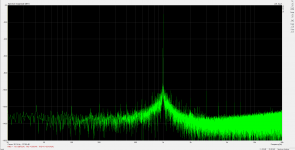 2018-08-28_18-14-08.png136.4 KB · Views: 173
2018-08-28_18-14-08.png136.4 KB · Views: 173 -
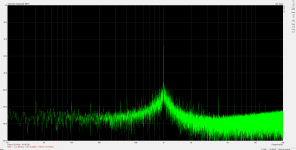 2018-08-28_18-13-21.png136.9 KB · Views: 211
2018-08-28_18-13-21.png136.9 KB · Views: 211 -
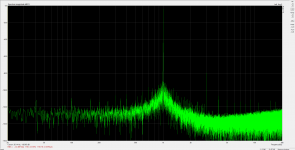 2018-08-28_18-12-34.png138.3 KB · Views: 1,621
2018-08-28_18-12-34.png138.3 KB · Views: 1,621 -
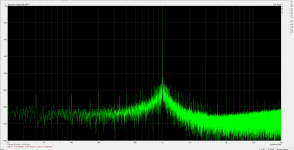 2018-08-28_18-11-46.png140.2 KB · Views: 1,678
2018-08-28_18-11-46.png140.2 KB · Views: 1,678
Actually, It does but differently for before and after critical current. Even 1W THD could be improved by the less dead time but of course, at 1/4 of max power the effect will be more bright. You can see(if loop gain is not too big, like UcD) some bump on the power sweep vs THD, where critical current reached. Anyway, if you'll see open loop headphone's amp with -3db THD<.02% let me know ))
I'm not a fan of reducing THD as I don't find it has much if any correlation with how the thing sounds. I prefer to focus on improving correlated PSRR (when noise from PSU is correlated with the signal and makes its way into the audio) - this improves dynamics. Hence I'd suggest my step-down trafo (with higher voltage rails) makes the thing sound more dynamic than your direct drive from 5V rails.
I get that for your customers low THD means quality, doesn't work for me though. PSRR does matter for the subjective results and I don't mean just pure PSRR, rather correlated PSRR. The output trafo does improve on that because it increases the ratio of load to supply impedance, both in theory and practice.
I had talking about another thing but it's ok )) The main idea is the standard logic is the nearest to an ideal candidate for headphone's Power DAC output stage. Unbeatable one and cheapest the same time!I get that for your customers low THD means quality, doesn't work for me though
Last edited:
I see. Done any experiments listening to the effect of adding more than 4000uF? When I did this I did get improvements with more capacitance but I wasn't using the naked USB bus power. In the end I found a single emitter follower worked best as regulator, base fed from a reference voltage.
The most disappointing thing to me it is differential outputs, that's requires special headphones which have differential inputs(4 wires). And planar type is preferable due to they have stable impedance vs frequency. So the amp is not too versatile yet. I believe dynamic headphones would be ok too but open-loop DAC will get some unneutral tonal signature.
The simple answer (albeit a bulky one) is transformers. They also allow you to match your amp to the right impedance/sensitivity. For example, IEMs are often very sensitive (low impedance) so need a high step-down ratio, the trafo ensures the noise doesn't become intrusive.
I think I don't need universal headphone's amp with additional trafo output and ratio switch for different headphones impedance. This project is simple and optimal for planars like HiFiman, Audeze, and similar. I do not consider that as a commercial project(because not too many users have Audeze or HiFiman with diff.inputs, and not all of them wants power DAC, next, only part of them sit all day afront of Mac/PC laptop with USB) and I ready to share it. However, diyaudio forum is changed last decade a lot, and now here is almost only buyers ))
My favourite amplifier was my Lyngdorf TDAI2200, which was a "Power DAC" using TI Equibit.
So to me, this is very interesting, as I'm a fan of this PCM-PWM approach. The downside of this design, as mentioned, is differential outputs.
Unfortunately I'm a "buyer" so can't help with any design suggestions!
So to me, this is very interesting, as I'm a fan of this PCM-PWM approach. The downside of this design, as mentioned, is differential outputs.
Unfortunately I'm a "buyer" so can't help with any design suggestions!
- Status
- This old topic is closed. If you want to reopen this topic, contact a moderator using the "Report Post" button.
- Home
- Vendor's Bazaar
- the TRUE digital one
